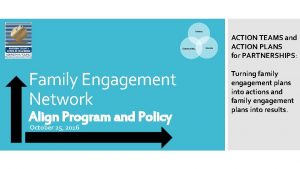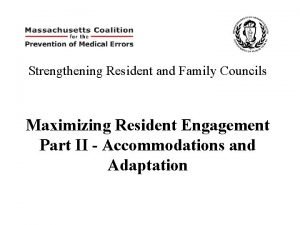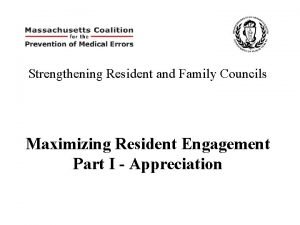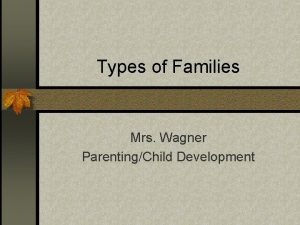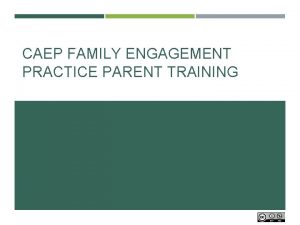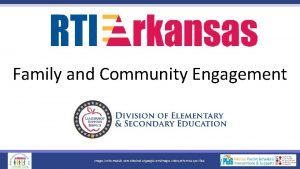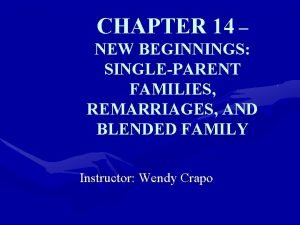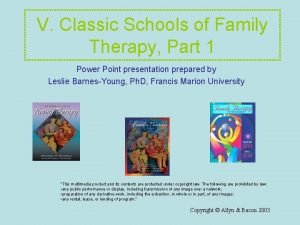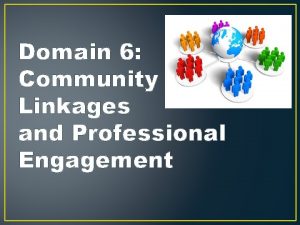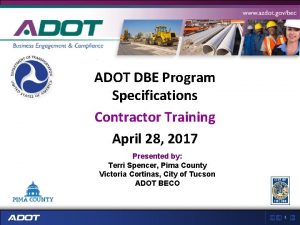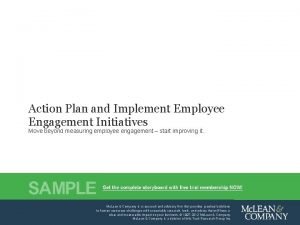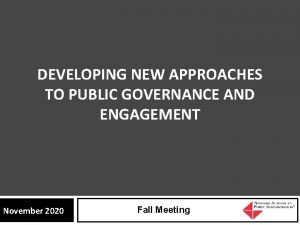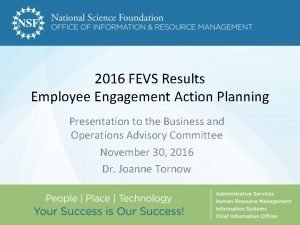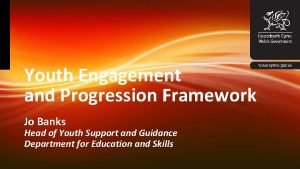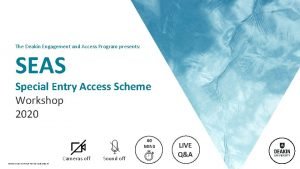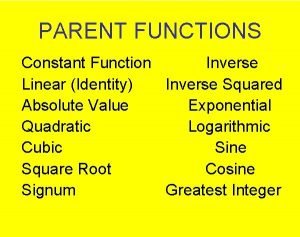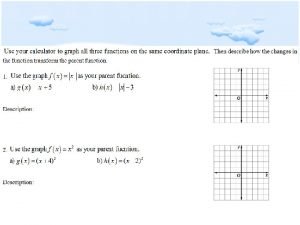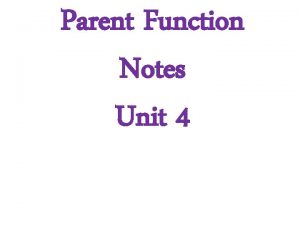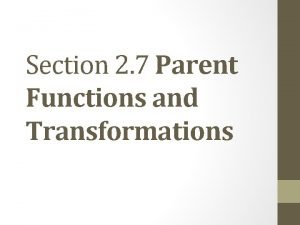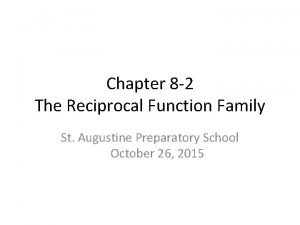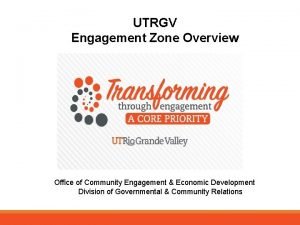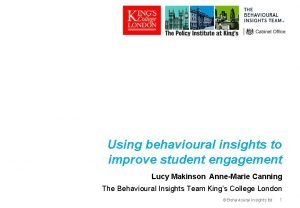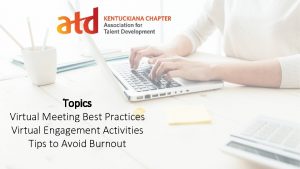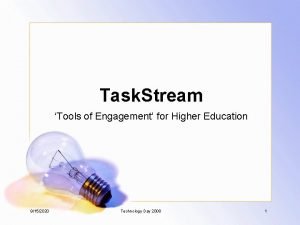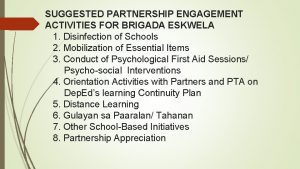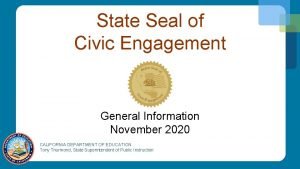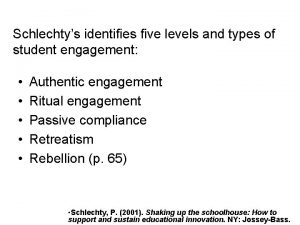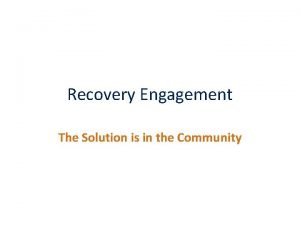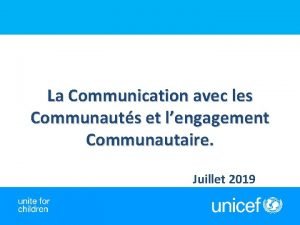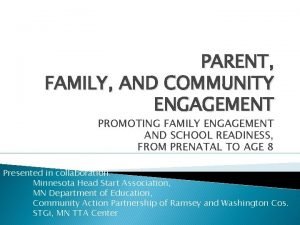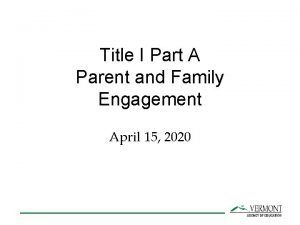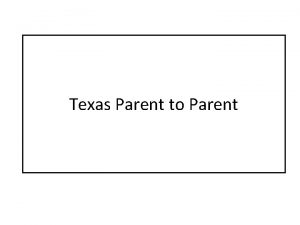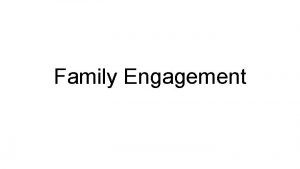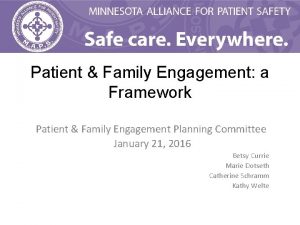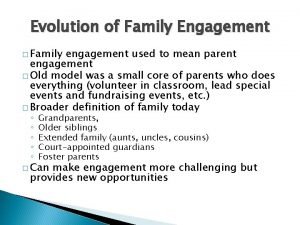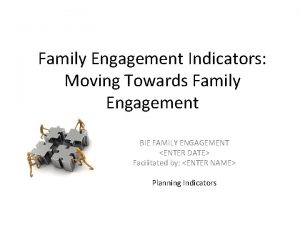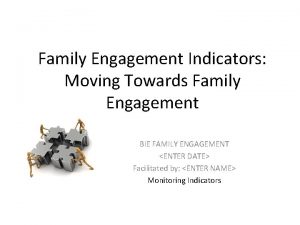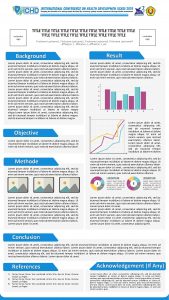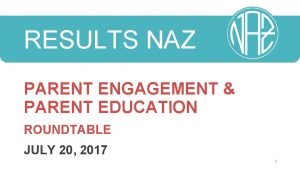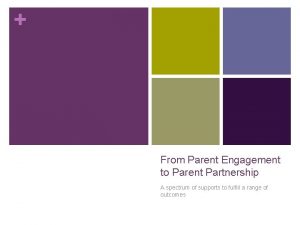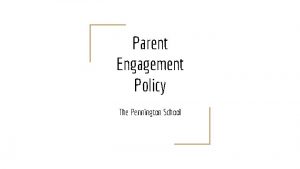Parent and Family Engagement in Title I Part

















![English Learners & Non-English Households 250, 000 [VALUE] 200, 000 150, 000 [VALUE] 19% English Learners & Non-English Households 250, 000 [VALUE] 200, 000 150, 000 [VALUE] 19%](https://slidetodoc.com/presentation_image_h/77bfb0bb1d3c07d21a10e84d9c83728f/image-18.jpg)






































- Slides: 56

Parent and Family Engagement in Title I, Part A PENELOPE MENA, TITLE I, PROGRAM SUPERVISOR OFFICE OF SUPERINTENDENT OF PUBLIC INSTRUCTION (OSPI)

Today’s Targets ü Learn key PFE requirements in Title I, Part A ü Answer questions • Some questions will be answered at the end of the presentation • If we cannot get to your question(s), please send them via email or call our office (contact information on last slide) • This webinar will be recorded and posted in the FP 201 profile page under Reference URLs and Materials. Please give us a couple of working days to post. OFFICE OF SUPERINTENDENT OF PUBLIC INSTRUCTION 11/10/2020 2

Why Family Engagement? OFFICE OF SUPERINTENDENT OF PUBLIC INSTRUCTION 11/10/2020 3

Regardless of socio-economic background, students with involved parents are more likely to: attend school regularly, enroll in higher level programs, earn high grades and test scores, show improved behavior, develop better social skills, Graduate, go to College or University. OFFICE OF SUPERINTENDENT OF PUBLIC INSTRUCTION 11/10/2020 A New Wave of Evidence, The Impact of School, Family and Community Connection on Student Achievement 2002. Ann T. Henderson, Karen L. Mapp. 4

PFE a Strategy not a Goal

Tips on creating a strategy Create PFE Activity Based on Look at your data • SIP • OSSI • SWP • TAS • Plan’s Needs Assessment, • Parent/staff Surveys, Evaluations Set the Opportunity and Process Conditions for Success. Create activities that are: • Relational • Developmental • Collaborative • Interactive • Linked to Learning Set Expectations and Outcomes. • Improving Student Attendance • Increasing Parent Participation • Increasing Parent/Staff Capacity • Increasing Student Achievement • Removing Barriers (child care, transportation, language) • Etc. U. S. Department of Education Dual Capacity Framework, (page 8) OFFICE OF SUPERINTENDENT OF PUBLIC INSTRUCTION 11/10/2020 6

PFE Activity Guide/Plan with Checklist Updated–PFE Activity Guide/Plan Template. Now includes a one page companion PFE activity checklist. This document helps in planning PFE activities based on the 5 opportunity and process conditions from ED's Dual Capacity Framework. In addition, it intends to serve as a guide for best practices when a Local Educational Agency (LEA) or school is planning PFE activities, such as Literacy, Math, Science Nights, etc. OFFICE OF SUPERINTENDENT OF PUBLIC INSTRUCTION 11/10/2020 Allowable Costs 7

Identifying Uses of Funds Template Identifying Uses of Funds for Allowable Activities template may be used as an LEA process for schools to request federal or state funding for an activity or service, and LEAs may adjust it or revise it to fit their needs OFFICE OF SUPERINTENDENT OF PUBLIC INSTRUCTION 11/10/2020 Fiscal Requirements and Guidance 8

Build Trust

Start with this premise: “All families, no matter what their income, race, education, language or culture, want their children to do well in school– and can make important contributions to their children’s learning. Even if your experience seems to cast doubt on this, thirty years of research bears it out. Let us begin with this spirit. “ OFFICE OF SUPERINTENDENT OF PUBLIC INSTRUCTION Beyond the Bake Sale, The Essential Guide to Family-School Partnerships by Anne T. Henderson, Karen L. Mapp, Vivian R. Johnson, and Don Davies

Conditions for effective two-way communication 1. Families have access to their child’s individual information and provide teachers with information about their child’s development. 2. Information is shared between families and teachers is understandable and meaningful. 3. Information is used and leveraged into positive action that teachers, families, and school leadership can take. OFFICE OF SUPERINTENDENT OF PUBLIC INSTRUCTION 11/10/2020 North Carolina Public Schools—Creating a culture of two-way communication 11

Tips for effective school-Parent communication Discuss contact methods with each parent at the beginning of the school year. • Use their preferences to create personal and classroom parent communication plans Share positive comments about the students with their parents. • When they have questions later in the school year, they’ll feel more comfortable coming to you OFFICE OF SUPERINTENDENT OF PUBLIC INSTRUCTION 11/10/2020 Make parent-teacher conferences a goalmaking discussion rather than an assessment or lecture. Be proactive with letting parents know about any concerns you have about their child. • That way, you can all work together to find a solution Document your communication efforts to keep track of what works best for each family. North Carolina Public Schools—Creating a culture of two-way communication 12

Address Differences in Culture, Class, Language, & Race

Tip for Addressing Differences OFFICE OF SUPERINTENDENT OF PUBLIC INSTRUCTION 11/10/2020 14

Demographic Considerations in WA q Students that are homeless or in adverse experiences q Students with Disabilities q Families who have negative feelings about school q Families who are learning English as an additional language q Families who work in agriculture, fishing, logging q Families from American Indian/Alaska Native communities q Family engagement decreases at grades 7 through 12 OFFICE OF SUPERINTENDENT OF PUBLIC INSTRUCTION 11/10/2020 15

Accessibility Provisions in Title I, Part A COMMUNICATIONS IN GENERAL, ENGLISH LEARNERS (EL), LIMITED ENGLISH PROFICIENT PARENTS AND PARENTS WITH DISABILITIES

Parents with Limited English Proficiency Basic Education Obligations Title I, Part A Requirements Interpretation and Translation Services All parents have the right to information about their child’s education in a language they can understand. Title IV Regulations | Chapter 28 A. 642 RCW | Chapter 392 -190 WAC Program information—written translations of printed information must be provided to parents with limited English proficiency in a language they understand, or, if not practicable, orally in a language that parents understand. LEAs and schools have flexibility in determining what mix of oral and written translation services may be necessary and reasonable for communicating the required information to parents with limited English proficiency. [Section 1116 (e)(f)] OFFICE OF SUPERINTENDENT OF PUBLIC INSTRUCTION 11/10/2020 17
![English Learners NonEnglish Households 250 000 VALUE 200 000 150 000 VALUE 19 English Learners & Non-English Households 250, 000 [VALUE] 200, 000 150, 000 [VALUE] 19%](https://slidetodoc.com/presentation_image_h/77bfb0bb1d3c07d21a10e84d9c83728f/image-18.jpg)
English Learners & Non-English Households 250, 000 [VALUE] 200, 000 150, 000 [VALUE] 19% 100, 000 10% 50, 000 0 English Learners 2018 -19 Non-English Households Total Student Population in WA State 1, 127, 493 OFFICE OF SUPERINTENDENT OF PUBLIC INSTRUCTION 11/10/2020 OSPI Student Information Data Report 2018 and 2018 -19, October 1 enrollment 18

Communication-Parents with Disabilities Make sure to Have proper supports and services when needed to give a parent with a disability an equal opportunity to participate… Honor their choice of communication. * * Unless the SEA, LEA, or school can demonstrate that another effective means of communication exists, or that use of the means chosen by the parent would result in a fundamental alteration of the service, program, or activity, or in an undue financial and administrative burden. OFFICE OF SUPERINTENDENT OF PUBLIC INSTRUCTION 11/10/2020 [28 CFR Sections 35. 104 and 35. 160– 164, and Appendix A to Part 35 of Title 28 T of the CFR Implementing Subtitle A of Title II of the Americans with Disabilities Act of 1990] 19

Additional Compliance, Best Practices, and Resources

PFE Website and Resources OFFICE OF SUPERINTENDENT OF PUBLIC INSTRUCTION 11/10/2020 21

Technical Assistance and Coordination LEA Role Provide coordination, technical assistance, and other support necessary to assist participating schools in the planning and implementing of effective Title I, Part A PFE activities. Also help them with PFE requirements to improve student academic achievement and school performance. OFFICE OF SUPERINTENDENT OF PUBLIC INSTRUCTION 11/10/2020 School Role School leadership has a responsibility to: 1. Involve staff in compliance implementation 2. Include staff and parents in the solutions that improve and strengthen family engagement. Coordination, Help and Support 22

Notification Requirements What LEAs and Schools Must Send Out and When helps clarify the statutory and regulatory requirements that apply to information that LEAs must provide to the parents of students who receive Title I, Part A services. This checklist is not complete, and does not include the consultation, collaboration, technical assistance, training, and other kinds of direct and indirect communication that occurs among school and LEA staff and the families and children they serve. • Parent Notification Requirements for LEAs and Schools (PDF) - To Parents of Students Who Receive Title I, Part A Services Resources • Parent Guides in Multiple Languages— Title I, Part A Programs and School Improvement OFFICE OF SUPERINTENDENT OF PUBLIC INSTRUCTION 11/10/2020 Communication 23

Title I, Part A Guide Title I Program, PFE, Private School, Fiscal, Reporting PFE Example Year-at-a-Glance Included in Title I, Part A Guide Pages 11, 20, 26, 46, 55 OFFICE OF SUPERINTENDENT OF PUBLIC INSTRUCTION 24

Updated—Timely Notice of Limited State Certification and Licensure Parents Right-To-Know: Timely Notice of Limited State Certification and Licensure Templates The federal Elementary and Secondary Education Act as amended by the Every Student Succeeds Act (ESSA) requires schools that receive Title I, Part A funds to notify parents or legal guardians when their child has been taught for four (4) consecutive weeks by a teacher who has not met "applicable State certification or licensure requirements at the grade level and subject area in which the teacher has been assigned. " [ESSA Sec. 1112(e)(1)(b)(ii)] In Washington, this notification requirement is for any teacher teaching under a limited substitute teaching certificate (WAC 181 -79 A-231), such as a Emergency Substitute certificate or Intern Substitute Teacher certificate. OFFICE OF SUPERINTENDENT OF PUBLIC INSTRUCTION 11/10/2020 25

PFE Policy/Plan Requirements LEA Level Policy q Board approval required q LEAs w/WSSDA Membership use policy 4130 (Updated February 2018) q LEAs without WSSDA Membership may use OSPI’s LEA template or their own with required ESSA components OFFICE OF SUPERINTENDENT OF PUBLIC INSTRUCTION 11/10/2020 School Level Plan q Board approval not required q Each Title I school must have a plan/policy q School(s) may use OSPI’s School template or create their own with required ESSA components Policy | Plan 26

LEA Policy and School Plan—Create a process to q Review the policy annually with parents/families q Partner with families to agree on your actions and roles, include these in your policy q Provide opportunities for families to share their concerns, ideas, and opinions q If applicable, use the feedback to revise your policy q Adopt the policy/plan q Share/disseminate: q LEA Policy: disseminate only to parents in participating schools q School Plan: SWP Program disseminate to all parents/families & TAS Program disseminate only to participating parents/families OFFICE OF SUPERINTENDENT OF PUBLIC INSTRUCTION 11/10/2020 Ways to disseminate: • Handout • Newsletter • Handbook, and (optional) • Bulletin Board—Poster Size, • Website* (see note section) Policy | Plan 27

Dissemination OSPI’s Citizen Complaint Procedures LEAs and/or schools disseminate adequate information about OSPI’s written complaint procedures for resolving federal statute or regulation violations that apply to Title I, Part A programs. This information must reach parents of students, and appropriate private school officials or representatives. Chapter 392 -168 WAC, Special Services Programs-Citizen Complaints that Allege Discrimination go to Equity and Civil Rights. Citizen Complaints - Federal Programs OFFICE OF SUPERINTENDENT OF PUBLIC INSTRUCTION 11/10/2020 28

School Requirement—Annual Meeting Hold an Annual Meeting to Let Parents Know about Title I, Part A Programs at Your Schools must 1) invite all parents of children who received Title I, Part A services and 2) hold a meeting — at least once in a school year — during which parents learn about: • Title I, Part A programs and services at your school • Requirements that govern this federal program • Parent’s right to be involved with Title I, Part A programs and services Preparation Tips and Templates for the Title I, Part A Program Meeting Announcement: English | Chinese | Khmer | Korean | Punjabi | Russian | Somali | Spanish | Tagalog | Vietnamese Agenda: English | Chinese | Khmer | Korean | Punjabi | Russian | Somali | Spanish | Tagalog | Vietnamese Power. Point Presentation: English OFFICE OF SUPERINTENDENT OF PUBLIC INSTRUCTION 11/10/2020 Policy | Plan 29

Building Capacity in PFE refers to any effort being made to improve the abilities, skills, and expertise of… Parents and School Staff OFFICE OF SUPERINTENDENT OF PUBLIC INSTRUCTION 11/10/2020 30

PFE Required Strategies to Building Capacity Provide trainings on: • How to monitor a child's progress, and • How to work with educators Assist parents in understanding the challenging State academic standards. Your Child’s Progress Coordinate and integrate parent engagement programs and activities with other Federal, State, and local programs. Provide materials and training to help parents to work with their children, such as literacy training and using technology. OFFICE OF SUPERINTENDENT OF PUBLIC INSTRUCTION 11/10/2020 Provide professional development to teachers, specialized instructional personnel, and other staff. Ensure that information related to school and parent programs, meetings, and other activities is sent in a format and, to the extent practicable, in a language the parents can understand. Essential PFE Strategies 31

Lower to Higher Impact PFE OFFICE OF SUPERINTENDENT OF PUBLIC INSTRUCTION 32 6/21/19 Flamboyant Foundation 2012 -Mid Atlantic Equity Consortium 2013

School–Parent Compact The compact takes the form of a written agreement that identifies specific activities–shared responsibilities–that parents, school staff, and students will carry out to improve academic achievement. The School-Parent Compact must also outline activities that build productive partnerships. With the help of parents, the compact must be reviewed and if necessary revised every year. OFFICE OF SUPERINTENDENT OF PUBLIC INSTRUCTION 11/10/2020 Dust Off Your Old School-Parent Compact, Your "New" Tool for Linking Family Engagement to Student Learning –Connecticut Department of Education These video presentations will help LEAs and school staff create a more meaningful grade level, goal oriented school-parent compact that helps children reach the learning goals of state academic standards. School-Parent Compact Templates–Georgia's Department of Education offers several examples of school-parent compacts as well as various useful tools. There is a template for each grade span–elementary, middle and high school; as well as traditional and innovative templates. Policy | Plan 33

Evaluation of the PFE Program and Activities Surveys LEAs and schools must conduct an annual evaluation of the content and effectiveness of their PFE policy and program. Families Forums Focus Groups OFFICE OF SUPERINTENDENT OF PUBLIC INSTRUCTION 11/10/2020 Annual Evaluation 34

Parent Advisory Board–(Optional) ü Schools are permitted to establish a parent advisory board that represents families as staff develop to evaluate school policy. Innovative Implementation Develop a schoolwide Ensure the parent advisory board Allow the parent representation reflects that elects a advisory board the composition of the representative to serve flexibility and authority student body, and on a districtwide Parent to establish plans and recruit future members Advisory Board ensuring set goals to improve PFE through effective equal representation of programs. networking, support, all Title I schools in the and training district. OFFICE OF SUPERINTENDENT OF PUBLIC INSTRUCTION 11/10/2020 35

Title I, Part A PFE Funding Under ESSA COMPLIANCE, BEST PRACTICES AND RESOURCES

Title I Funded LEAs and Schools Title I Funded • LEAs and School must fulfill and implement Parent and Family Engagement requirements of Section 1116 of ESSA regardless of amount of allocation. OFFICE OF SUPERINTENDENT OF PUBLIC INSTRUCTION 11/10/2020 37

LEAs with over $500, 000 Allocation One percent set-aside is required if your district has an allocation of $500, 000 or more. Calculate your PFE set-aside by taking one percent of your total allocation. Of that one percent, no less than 90% must go to Title I buildings. The remaining 10% (or less) may remain at the district level. OFFICE OF SUPERINTENDENT OF PUBLIC INSTRUCTION 11/10/2020 38

Request parent input annually on how to spend the PFE funds LEA with over $500, 000 allocation must ü Involve parents and families in the decisions on how the one percent will be used for PFE activities. ü Use the required one percent set-aside in allowable PFE activities. ü Track how participating schools use their allocation for PFE activities. Sample Survey from the Georgia Department of Education. OFFICE OF SUPERINTENDENT OF PUBLIC INSTRUCTION 11/10/2020 Funding 39

Additional Requirements LEA’s with over $500, 000 Allocation Carry out at least one of the following: Providing professional development for local educational agency and school personnel Supporting programs that reach parents and family members at home, in the community, and at school. Disseminating information on best practices focused on parent and family engagement Collaborating, or providing subgrants to schools to enable such schools to collaborate, with community-based or other organizations or employers Engaging in any other activities and strategies that the local educational agency determines are appropriate OFFICE OF SUPERINTENDENT OF PUBLIC INSTRUCTION 11/10/2020 Funding 40

Allowable Costs Take Advantage of Funding for Allowable Activities LEAs and schools must provide a broad range of services designed to help parents help their children succeed at school - Section 1116 of ESSA. The activities allowable under the parent and family engagement provisions of Title I, Part A are reasonably broad in scope, but generally linked to: 1. Education and training, 2. Participation in school-related meetings and 3. Inclusion in the education of their children. 4. Removing barrier(s) for greater participation, so families can attend intentional activities that are linked to achievement goals and help build their intellectual, social, and human capital. OFFICE OF SUPERINTENDENT OF PUBLIC INSTRUCTION 11/10/2020 Allowable Costs 41

PFE and Early Learning

Importance of Family Engagement in the Early Years “The research indicates that families’ involvement in children’s learning and development impacts lifelong health, developmental, and academic outcomes. Engaging with families is especially crucial in the early years of learning since this is the stage during which young children acquire foundational competencies, such as language, literacy, and social-emotional skills that strongly affect their capacity for life-long learning. ” See the U. S. Departments of Education and Health and Human Services’ joint “Policy Statement on Family Engagement: From the Early Years to the Early Grades” for more information. OFFICE OF SUPERINTENDENT OF PUBLIC INSTRUCTION 11/10/2020 43

Funding Opportunities to Engage Families in the Early Years Title I, Part A funds can be used for reasonable activities that bring families of eligible children into the building to participate in the learning/teaching process. Funds can be used to: 1. Train family members in early learning teaching techniques and to support the transition process. a. 2. Transportation of parents to attend these training meetings. As long as these are parents of eligible children and the training includes an educational component (e. g. techniques for reading with children, home math activities, etc. ). The availability of other sources should be considered before Title I, Part A funds are used for transportation Provide professional development for school personnel, including early childhood educators, regarding parent and family engagement strategies (Title I could be combined with Title II funds). 1. “Private childcare and preschool providers can participate in that professional development if the children they serve will attend kindergarten at a targeted assistance building and are identified as most at risk, or will attend kindergarten at a schoolwide building when they reach that age. ” OFFICE OF SUPERINTENDENT OF PUBLIC INSTRUCTION 11/10/2020 Funding Early Learning Activities in Washington State with Title I, Part A (Birth – Age 5) (PDF) Early Learning in the Every Student Succeeds Act Non-Regulatory Guidance 44

West Valley Yakima SD – Home Visitor Program Title I Part A set-aside funds are used for the Parent Child Home Program, a home visitor program that focuses on early learning. A staff member from the school district visits families twice a week for 23 weeks over a two year span. The program serves children who are 2, 3, and 4 years old. Through the Parent Child Home Program, parents experience the joy and value of reading, talking, and playing with their child. Each family in the program receives books and educational toys within the context of 92 homes visits. Home visitors generate excitement about learning and verbal interaction in the home through books, toys, and play. Home visitors model quality reading, conservation, and play with the emphasis of the parent’s role as the child’s first teacher. OFFICE OF SUPERINTENDENT OF PUBLIC INSTRUCTION 11/10/2020 The program serves 45 families of which 60% are minority, primarily Hispanic, and 85% have an income below $25, 000 annual salary. Funding Early Learning Activities in Washington State with Title I, Part A (Birth – Age 5) 45

PFE and CPR Monitoring

CPR Items 2019 -20 Items Sections Fiscal 1. 1, 1. 2, 1. 3 Student Achievement & Equitable Services 1. 4, 1. 5, 1. 6 Parent and Family Engagement 1. 7, 1. 8, 1. 9, 1. 10, 1. 11, 1. 12, 1. 13, 1. 14 • • • • Ranking and Allocation Required Set-Asides Supplement Not Supplant School Program Models Schoolwide (SWP) Targeted Assistance (TAS) OFFICE OF SUPERINTENDENT OF PUBLIC INSTRUCTION 11/10/2020 • • SWP Plan Evaluation Process SWP TAS Plan Evaluation Process TAS 3 3 Annual Report Card 95 Participation in State Assessments Equitable Services – Private Schools LEA Level Policy One Percent Input Complaint Procedure Dissemination Notification Teacher and Para Qualification PFE Required Strategies School Level PFE Plan School-Parent Compact PFE Accessibility Number of Items 8 1. 15, 1. 16, 1. 17, 1. 18 4 47

Title I, Part A CPR Items with Examples Description of Evidence Needed Resources, Tools, Templates Examples of Compliant Items OFFICE OF SUPERINTENDENT OF PUBLIC INSTRUCTION 11/10/2020 48

PFE Resources

Resources Guides & Tools to Build an Effective PFE Program 11/10/2020 OFFICE OF SUPERINTENDENT OF PUBLIC INSTRUCTION 50

PFE Bulletin Parent and Family Engagement • Bulletin No. 045 -19 2019 -20 OFFICE OF SUPERINTENDENT OF PUBLIC INSTRUCTION 11/10/2020 51

Updated Version Coming Soon ESSA allows some funding sources to be merged, or “braided, ” to support programs that improve student learning. Unlocking Federal and State Program Funds to Support Student Success guidance document. PFE Section (Pages 47 -58) OFFICE OF SUPERINTENDENT OF PUBLIC INSTRUCTION 11/10/2020 52

Share your Story of Effective Parent and Family Engagement Strategies This case study form is provided by the Title I, Part A and Learning Assistance (LAP) department at the Office of Superintendent of Public Instruction (OSPI) to gather descriptive information from K– 12 schools on specific PFE strategies (i. e. , larger district-wide initiatives or smaller projects involving one or more classrooms) that have helped to increase student academic outcomes. Use this for activities that were funded with federal or state dollars as well as projects that were supported by local or other funding sources. Next steps: • Complete all questions and save this document for your records. • Email completed form to Penelope. mena@k 12. wa. us • Story review by OSPI staff • Selected stories will be highlighted in the PFE newsletter and on the Title I, Part A PFE Website—Share Your Story! OFFICE OF SUPERINTENDENT OF PUBLIC INSTRUCTION 11/10/2020 53

Other Resources 1. Resources for Families-OSPI 2. Bilingual Department ◦ Parent Guardian Notifications & Forms and Translated Material 3. Migrant Education ◦ Parent Advisory Council Guide English | Spanish 4. LAP Menus of Best Practices ◦ Each menu (ELA, Math, Behavior) has a section on Family and Community Practices and Strategies 5. Special Education-Guidance for Families 6. Consolidated Program Review ◦ Checklist–Includes the Tile I, Part A PFE requirements OFFICE OF SUPERINTENDENT OF PUBLIC INSTRUCTION 11/10/2020 54

Register for Gov. Delivery q. Title I, Part A q. Learning Assistance Program (LAP) q. Parent and Family Engagement q. ESSA q. Consolidated Program Review (CPR) q. Other programs OFFICE OF SUPERINTENDENT OF PUBLIC INSTRUCTION 11/10/2020 55

Questions & Technical Assistance Title I/LAP and CPR Main Line 360 -725 -6100 Title I, Part A Program Supervisors – Title I, Part A Alyssa Ibañez, 360 -725 -6172 Coleen Putaansuu, 360 -725 -6104 Jason Miller, 360 -725 -6232 Larry Fazzari, 360 -725 -6189 Mary Jo Johnson, 360 -725 -6103 Penelope Mena, 360 -725 -6069 PFE Lead OFFICE OF SUPERINTENDENT OF PUBLIC INSTRUCTION 11/10/2020 56
 Parent engagement network
Parent engagement network Resident and family engagement
Resident and family engagement Resident and family engagement
Resident and family engagement Whats immediate family
Whats immediate family Advantage and disadvantage of single parent family
Advantage and disadvantage of single parent family Title fly and title page
Title fly and title page Caep family engagement
Caep family engagement Family engagement images
Family engagement images Blended family vs binuclear
Blended family vs binuclear Tartarus family tree
Tartarus family tree Title title
Title title Conjugal family
Conjugal family Part whole model subtraction
Part whole model subtraction Unit ratio definition
Unit ratio definition Part part whole
Part part whole Part by part technical description example
Part by part technical description example Standard bar parts and layout
Standard bar parts and layout The part of a shadow surrounding the darkest part
The part of a shadow surrounding the darkest part Two way anova minitab 17
Two way anova minitab 17 Family therapy part 2
Family therapy part 2 What story made the profoundest impression of rizal
What story made the profoundest impression of rizal Schools of family therapy
Schools of family therapy Periodic table staircase
Periodic table staircase Principles of marketing chapter 1
Principles of marketing chapter 1 Domain 6: community linkages explanation
Domain 6: community linkages explanation Adot - business engagement and compliance (beco)
Adot - business engagement and compliance (beco) Action plan for employee engagement
Action plan for employee engagement Develop new approaches to public governance and engagement
Develop new approaches to public governance and engagement Cmop-e
Cmop-e Employee engagement survey action plan ppt
Employee engagement survey action plan ppt Youth engagement and progression framework
Youth engagement and progression framework Seas category 4
Seas category 4 What is the c horizon
What is the c horizon Parent inverse function
Parent inverse function Parent function transformations
Parent function transformations Parent functions notes
Parent functions notes Parent functions transformations
Parent functions transformations Parent functions and transformations
Parent functions and transformations Threshold limit value of ammonia
Threshold limit value of ammonia Benchmarkk
Benchmarkk Parent functions and transformations
Parent functions and transformations Lesson 2 the reciprocal function family
Lesson 2 the reciprocal function family Utrgv mission statement
Utrgv mission statement Lucy makinson
Lucy makinson Employee engagement programs examples
Employee engagement programs examples Personal board
Personal board Corinna betsch
Corinna betsch Taskstream tools of engagement
Taskstream tools of engagement Brigada eskwela program of activities
Brigada eskwela program of activities California state seal of civic engagement
California state seal of civic engagement Iso stakeholder engagement
Iso stakeholder engagement Schlechty's levels of engagement
Schlechty's levels of engagement Recovery engagement center bloomington indiana
Recovery engagement center bloomington indiana Philosophical chairs
Philosophical chairs What does nic mean in nursing
What does nic mean in nursing Partner engagement model
Partner engagement model Engagement communautaire et redevabilité
Engagement communautaire et redevabilité
